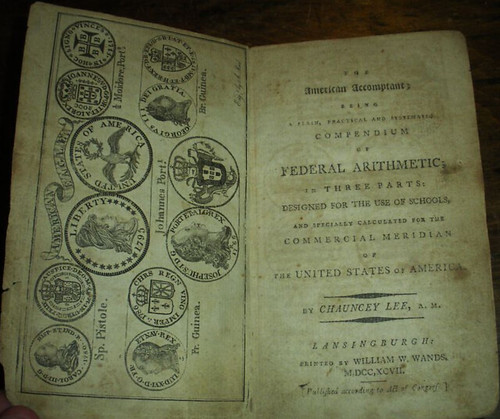
PREV ARTICLE
NEXT ARTICLE
FULL ISSUE
PREV FULL ISSUE
THE AMERICAN ACCOMPTANT: 1797 BOOK USING DOLLAR SIGNE-Sylum reader Adrián González forwarded a link to an interesting item for sale on eBay. Perusing old books at eBay I found the following old book. I know it isn't a numismatic book but it contains a 1795 eagle gold coin including other British coins.

As described in the seller's listing (IN ALL CAPITAL LETTERS!!!!), the book is: THE AMERICAN ACCOMPTANT BEING A PLAIN PRACTICAL AND SYSTEMATIC COMPENDIUM OF FEDERAL ARITHMETIC IN THREE PARTS DESIGNED FOR THE USE OF SCHOOLS AND SPECIALLY CALCULATED FOR THE COMMERCIAL MERIDIAN OF THE UNITED STATES OF AMERICA BY CHAUNCEY LEE LANSINGBURGH PRINTED BY WILLIAM W WANDS MDCCXCVII ( 1797 ) Other descriptions include: HERE IS A VERY RARE BOOK - IT IS THE FIRST TIME EVER THAT THE UNITED STATES DOLLAR SIGN $$$ WAS EVER USED IN PRINT FANTASTIC ENGRAVING FRONTISPIECE WITH THE 1795 LIBERTY DOLLAR AMONG OTHER COINS OF THE TIME SIGNED OWNERSHIP TO ISAAC SPAULDING HIS BOOK BOUGHT IN NORFOLK FEBRUARY 15TH 1800 The contemporary illustrations of circulating coins are important clues for numismatic researchers, but what most caught my eye was the claim that the book contains the first printed representation of the U.S. dollar sign ($). Is that true? The seller didn't list his source for the claim, but knowing that our friend Eric Newman researched the topic, I reached for a copy of his paper, which was published in the proceedings of the 1993 Coinage of the Americas conference at the American Numismatic Society in New York. Newman does cite and illustrate the 1797 Lee book. Newman writes: Lee's symbol for the dollar was called to the attention of the numismatic public in The Numismatist for September 1899 and was generally accepted as the first printed use of the conventional dollar sign until 1925 when Professor Florian Cajori challenged it. An examination of Lee's , particularly his dollar symbol, shows that they were original with him and that he was not familiar with the existing conventional $ sign... Granted he was the first to develop a symbol for the dollar in type form rather than spelling out "dollar" or employing an abbreviation, but it appears to be an isolated concept, unrelated to the prior handwritten $ sign. Sorry, eBay seller - your description isn't accurate. Still, it's a neat item worth of inclusion in a numismatic library. Readers, check out Newman's monograph. It's meticulously researched and very well written, illustrated and annotated. Joel Orosz adds: I was fortunate several years ago to pick up a pristine copy of Chauncey Lee's "American Accomptant", which I have enjoyed very much. It looks like this one is a pretty nice copy as well. Definitely worth having in a bibliophile's library!
To view the complete eBay fixed-price listing, see:
1797 AMERICAN ACCOMPTANT FEDERAL MATH 1ST USE OF $ SIGN
(cgi.ebay.com/1797-AMERICAN-ACCOMPTANT- THE BOOK BAZARRESALE 14 CLOSING DATE CHANGE PLEASE MARK YOUR CALENDARS OCTOBER 15, 2011 - MAIL BID SALE NO. 14 www.finenumismaticbooks.com. PH: (719) 302-5686, FAX: (719) 302-4933. EMAIL: numismaticbooks@aol.com. USPS: Box 6321, Colorado Springs, CO. 80934. Contact me for your numismatic literature needs! Wayne Homren, Editor The Numismatic Bibliomania Society is a non-profit organization promoting numismatic literature. See our web site at coinbooks.org. To submit items for publication in The E-Sylum, write to the Editor at this address: whomren@gmail.com To subscribe go to: https://my.binhost.com/lists/listinfo/esylum All Rights Reserved. NBS Home Page Contact the NBS webmaster 
|